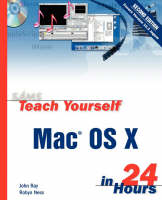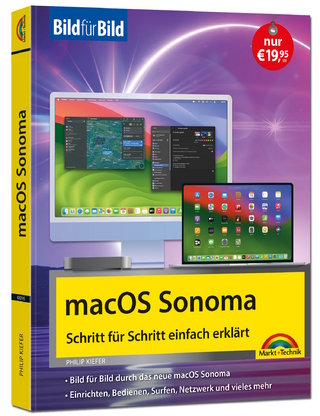
Sams Teach Yourself Mac OS X in 24 Hours
Sams Publishing (Verlag)
978-0-672-32474-1 (ISBN)
- Titel ist leider vergriffen;
keine Neuauflage - Artikel merken
Underneath the colorful interface of Mac OS X is a powerful, complicated operating system based on BSD Unix. And Mac users of all kinds need help both in figuring out how to run OS X and in understanding how it worked and how to get the most out of it.
In late Summer 2002 Apple is expected to release a new version of OS X -- code-named "Jaguar" -- that will add some end user features (like iChat), and that will improve OS X's stability.
The second edition of Sams Teach Yourself Mac OS X in 24 Hours helps new users to understand how the new OS (different from the traditional Mac OS, as well as Windows) functions, and how to use it successfully. The book also explores how to use the native OS X applications that ship with the product.
John Ray is an award-winning developer and security consultant with more than 16 years of programming and administration experience. He has worked on projects for the FCC, the National Regulatory Research Institute, The Ohio State University, Xerox, and the State of Florida, as well as serving as IT Director for Blue Cosmos Design, Inc. He has written or contributed to more than 10 titles currently in print, including Mac OS X Unleashed, Special Edition Using TCP/IP, Sams Teach Yourself Dreamweaver MX Application Development in 21 Days, and Maximum Linux Security. He bought his first Macintosh in 1984 and remains a strong proponent for the computer and operating system that revolutionized the industry. Robyn Ness holds a master's degree in psychology with a specialization in judgment and decision making. She currently works as a Web developer for the Section of Communications and Technology at The Ohio State University, focusing on issues of usability and content design.
(NOTE: Each chapter concludes with a Summary, Q&A, and Workshop.)
Introduction.
I. INTRODUCTION TO MAC OS X.
Hour 1. A Tour of Mac OS X.
Setting Up Mac OS X. Understanding Mac OS X Architecture. Applications Included with Mac OS X. System Preferences. The Mac OS X Desktop.
Hour 2. Using the Finder and the Dock.
The Finder Window. The File System. Performing File and Content Searches. The Finder Menu Bar. Task: Burn a Disc. The Dock.
Hour 3. Basic Applications for Productivity and Recreation.
Desk Accessories. Preview. TextEdit. Ink. Chess.
Hour 4. Installing New Applications.
Software Sources. Task: Downloading and Installing Software. Opening Compressed Files with StuffIt Expander. Software Considerations in a Multiuser System. Some Software Suggestions.
II. GRAPHICS AND MULTIMEDIA.
Hour 5. iTunes.
iTunes. Task: Creating and Working with Playlists.
Hour 6. iPhoto.
Using iPhoto.
Hour 7. QuickTime and iMovie.
QuickTime. iMovie.
Hour 8. DVD Player and iDVD.
DVD Player. iDVD Basics. Advanced Features.
III. NETWORK AND INTERNET.
Hour 9. Setting Up Mac OS X Networking.
Creating an Internet Connection. Setting Network Port Priorities and Locations. Using Internet Connect.
Hour 10. Web Browsing and .Mac Membership.
The Internet Explorer Interface. Task: Using the Address Bar and the Button Bar. Task: Using and Adding Favorites in the Explorer Bar. .Mac.
Hour 11. Sherlock.
Sherlock Channels. Sherlock Preferences.
Hour 12. Mail and iChat.
Mail. Address Book. iChat.
Hour 13. Using Network Sharing.
Sharing Services. Connecting to Shared Folders. Sharing Your Internet Connection.
Hour 14. Keychain Access and Network Utility.
Keychain Access. Network Utility: A Quick Overview.
IV. ADVANCED SYSTEM CONFIGURATION.
Hour 15. Sharing Your System: Multiple Users.
Understanding Mac OS X User Accounts. Logging In. Adding and Removing Users. Controlling File Permissions. Understanding Groups. The Root Account.
Hour 16. Setting Up Printers and Fonts.
Using Print Center. Common Printer Settings. Adding Fonts. Using the Mac OS X Fonts Panel.
Hour 17. Monitors and ColorSync.
Configuring Displays. Using the Display Calibrator Assistant. Task: Calibrate Your Display. Introduction to ColorSync. ColorSync System Preferences Panel. ColorSync Utility.
Hour 18. Accessibility Features and Additional System Preferences.
Personal System Preferences. Hardware System Preferences. Internet and Network System Preferences. System Preferences. Universal Access.
V. ADVANCED MAC OS X FEATURES.
Hour 19. Automating Tasks with AppleScript.
What Is AppleScript?. Using the Script Editor. Scripting Syntax. Script Menu.
Hour 20. UNIX Command Line Tour.
Terminal: The Window to the Underworld. Working with Files: Basic Commands. Process Management. Server Administration. Getting Help with Manpages. Other Useful Commands.
Hour 21. UNIX Advantages: The Power of UNIX.
Scripting Languages. X Window System. Server Applications and Tools.
Hour 22. System Utilities and Monitors.
Disk Utility. Disk Copy. Task: Creating Disk Images. Task: Burning CDs. System Profiler. Process Viewer. Force Quit a Process. CPU Monitor. Task: Adding the CPU Monitor to Your Menu Bar.
Hour 23. Security Considerations.
Mac OS X Security. Implementing Local System Security. Maintaining Security Online.
Hour 24. Maintenance and Troubleshooting.
Automating Software Updates. Backing Up Your Data. Diagnostics. Restoring the Administrator Password. Viruses.
VI. APPENDIX.
Appendix A. Installing Mac OS X.
Mac OS X System Requirements. Preparing Your Hard Drive for Mac OS X. Partitioning Your Drive. Installing Mac OS 9. Installing Mac OS X.
Appendix B. Running Classic Applications.
Launching Classic. The Boot Process. Running Classic Applications. Classic Options. Direct Booting to Mac OS 9 and Back to Mac OS X.
Appendix C. Working with Files, Folders, and Applications.
Moving Files and Folders. Renaming Files. Copying Files and Folders. Deleting Files and Folders. Creating Aliases. Opening Unrecognized Files. Force Quitting Applications with the Process Manager.
Index.
| Erscheint lt. Verlag | 14.11.2002 |
|---|---|
| Verlagsort | Indianapolis |
| Sprache | englisch |
| Maße | 188 x 231 mm |
| Gewicht | 739 g |
| Themenwelt | Informatik ► Betriebssysteme / Server ► Macintosh / Mac OS X |
| Informatik ► Betriebssysteme / Server ► Windows | |
| ISBN-10 | 0-672-32474-1 / 0672324741 |
| ISBN-13 | 978-0-672-32474-1 / 9780672324741 |
| Zustand | Neuware |
| Haben Sie eine Frage zum Produkt? |
aus dem Bereich


